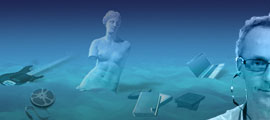Archive
Titus Groan
 A lot has been said about this book and this trilogy. The soundbite I have in my head for it is ‘a sustained work of the imagination’. It is definitely that. The narrative and characters are pushed to heights which, in different hands, would be ridiculous, but Peake manages to keep things engaging and ‘real’ with heavyweight characters and doses of allegory which are not so far removed from what we (UK, the aristocracy, old people, young go-getters, the yoke of tradition etc.) are actually like. His descriptions of place are so vivid you can almost feel the moss-covered stone or the dusty old velvet of Gormenghast castle.
A lot has been said about this book and this trilogy. The soundbite I have in my head for it is ‘a sustained work of the imagination’. It is definitely that. The narrative and characters are pushed to heights which, in different hands, would be ridiculous, but Peake manages to keep things engaging and ‘real’ with heavyweight characters and doses of allegory which are not so far removed from what we (UK, the aristocracy, old people, young go-getters, the yoke of tradition etc.) are actually like. His descriptions of place are so vivid you can almost feel the moss-covered stone or the dusty old velvet of Gormenghast castle.There are many things I loved about this book:
I’ve mentioned before that I like owls. It was this book that really cemented my appreciation of them. In it owls are associated with learning and wisdom – constantly circling the tower and the library – but when the tower burns down and the Earl loses his mind it is the owls that dispatch him. They are not just wise and enigmatic, but also vicious and deadly.
In the version of the books I have there are several of Peake’s sketches he drew of his characters. Fuscia, on the cover of this one, is draw with a very heavy hand. There are other pictures which are drawn with a very light hand. Rather than these insane freakish protraits being caricatures or monsters, they are in fact credible representations of how these characters may actually look.
After reading this book I identified The Smiths’ This Charming Man with it. I assumed that Morrisey had written the line ‘a jumped up pantry boy who never knew his place’ about Steerpike. I’ve since learned that that is not the case, but I retain the association. I’m sure Morrisey wouldn’t mind.
Samuel Beckett
I started reading Samuel Beckett when I was at college and planned to do my thesis on his place within Post-Modernism. I’m glad I left before obliging myself to squeeze him into such a prescriptive box.
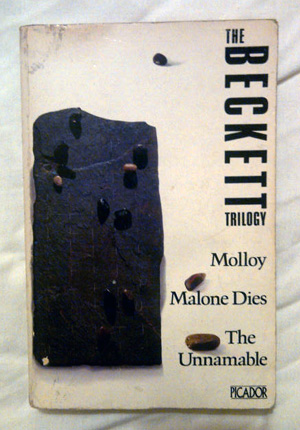 I continued reading Beckett long after college when it was no longer necessary to categorise him. Looking at the development and transformation in his writing from the early novels like Mercier and Camier to the later writing like Ill Seen Ill Said and Worstward Ho the only category that could really contain his work would be the category of truly great, eternal writers. His enduring vision of some bleak metaphysical existence, articulated with razor sharp, beautiful prose, captivated me for good.
I continued reading Beckett long after college when it was no longer necessary to categorise him. Looking at the development and transformation in his writing from the early novels like Mercier and Camier to the later writing like Ill Seen Ill Said and Worstward Ho the only category that could really contain his work would be the category of truly great, eternal writers. His enduring vision of some bleak metaphysical existence, articulated with razor sharp, beautiful prose, captivated me for good.
Beckett wrote much of his best work in French. He loved the economy of that language. I speak a little French and understand the attraction, though I’ve never attempted the French originals. As it was Beckett himself who translated the works back into English I can be assured they are as faithful as can be.
I was going to use a photograph of the author to accompany this post but I’m sure everyone is familiar with his chiselled, world-worn features in stark black and white. Instead I took a photo of my copy of his Trilogy. I was reading this around the time my first son was born. I named him Samuel in the same spirit that I named my second son Charles.
I paraphrase his ‘fail better’ quote as my Twitter bio.
Jung – Memories, Dreams, Reflections
Can’t remember what drew me to this book. Part of my Uni course was psychology and we discussed Freud but steadfastly avoided Jung. Perhaps it was this implication of controversy that made me pick up this book years later.
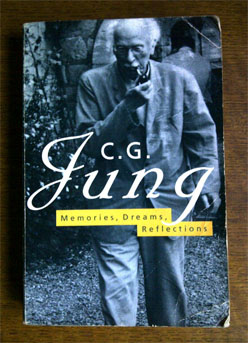 It wasn’t many pages in before I knew I was going to love this book. Jung has written this book the way an author writes, rather than the way an academic would write. His entire approach seems to be unscientific depending instead for validation upon observation, reasoning and imagination. His ideas on popular consciousness, shadows, archetypes, anima/animus give structure to a narrative which we as individuals, and as a race, are part of.
It wasn’t many pages in before I knew I was going to love this book. Jung has written this book the way an author writes, rather than the way an academic would write. His entire approach seems to be unscientific depending instead for validation upon observation, reasoning and imagination. His ideas on popular consciousness, shadows, archetypes, anima/animus give structure to a narrative which we as individuals, and as a race, are part of.
Jung frequently presents truths in the way that only an artist or poet could. My favourite passage is when he considers the way we have some knowledge and behaviour innate within us from beyond the reach of our lifetimes and known by others who also experience the same environment. Jung mentions observing a group of chattering, clamouring monkeys on a cliff face who all stopped what they are doing and turn to watch the sunrise.
I like that he accepts some things just are, without feeling the need to invent a science to prove it. When asked whether he believed in God, he replied something along the lines of: you can’t argue over the existence of God any more than the beauty of a flower or the terrors of the night.
I haven’t read many autobiographies. One of the handful of others I’ve read was that of Hermann Hesse. Apparently Hesse underwent some psychoanalysis from Jung. It would be fascinating to see a transcript of those sessions.
Alasdair Gray
Alasdair Gray represents much of what I love about Scotland and makes me proud to be Scottish. There’s little point in attempting to categorise him as either an artist or a writer. He’s a top rank of one of each, and that makes him something else entirely: something rare; something from another era, or something rare yet eternal. He’s also fiercely political. Whatever passion it is that drives him is powerful and has been sustained throughout his long and fruitful life.
 His books cover, among other subjects, social observation, sexual fantasy and historical fiction. He also indulges his political convictions directly in books about Scottish Independence. We all know of Lanark, his part fiction, part autobiography oscillating between crystal clear realism and nightmare surrealism. We should have all read it. Lanark was my introduction to Alasdair Gray. It was unlike anything else I had read or have read since and though his other books are also excellent in degrees, none quite equalled Lanark’s bold and visionary stature.
His books cover, among other subjects, social observation, sexual fantasy and historical fiction. He also indulges his political convictions directly in books about Scottish Independence. We all know of Lanark, his part fiction, part autobiography oscillating between crystal clear realism and nightmare surrealism. We should have all read it. Lanark was my introduction to Alasdair Gray. It was unlike anything else I had read or have read since and though his other books are also excellent in degrees, none quite equalled Lanark’s bold and visionary stature.
An aspect of Lanark which I couldn’t overlook was the book’s illustrations, which I now see are based on Hobbe’s Leviathan, and its packaging. His artistic vision permeated every aspect of the book, and whilst my enthusiasm for his books levelled out (at a pretty high level), my enthusiasm for his art steadily increased with each new item I saw.
I’m so grateful that Alasdair Gray took the time to produce ‘A Life in Pictures’ which catalogues most of his artistic output. This book not only presents a fantastic collection of art – from student drawings to posters, book illustrations, paintings, murals and ceilings – but thoroughly endeared me to Alasdair Gray the man, the artist, the polymath, the Scot.
The Demon by Hubert Selby jr
I’ve started reading a lot of books by American authors. I even finished one by Henry James when I was studying. I usually get the impression that they like the sound of their own voice a bit too much.
 Except for Hubert Selby jr.
Except for Hubert Selby jr.
I came to this writer, as most us probably did, via Last Exit to Brooklyn. I saw the film of this first and picked up the book in a jumble sale. I wanted to like American writers so I gave it a go and found he didn’t have the hang-ups of consciousness that his compatriots had. I loved it. I then picked up The Room in a second hand shop and loved that. Then I couldn’t find any more of his books in shops.
This was in the mid nineties, before the internet had made everything available everywhere. The utterly scandalous content of these books had brought down the full wrath of censoring agencies in and around the sixties on both sides of the Atlantic. But the embargo had been lifted as a new wave of loathsome, deviant and corrupting publications took their place (mainly celebrity autobiographies). I asked my wife for The Demon one Christmas and she managed to acquire the edition pictured here.
Very powerful stuff. Selby inspires a strong response to the depravity of his characters, but what is perhaps the most disturbing aspect of his books is what he draws to the surface from the hidden depths of his readers. I’ll never stand at the edge of a crowded railway platform again.
The Selfish Giant
Who hath dared to wound thee?
I remember seeing the animated version of this story when I was very young. I had enjoyed it as a kind of fairy story/fable. I felt the terror of the children when the giant returned, the cold of the snow and wind when they came to the giant’s garden and the joy when he took his axe to the wall and allowed the children back in. I liked the little boy in the tree alone surrounded by snow in the corner. The ending, though, had made little impression on me. I guess I must have been confused by it. Who was that little boy? What were the wounds of love? How could I feel both happy and sad at the same thing? 
I picked the book up in a second hand shop to for one of the kids and read it to him when he was about five. Wilde’s prose is super efficient; none of the verbal contortions and self-concious wit of his ‘adult’ books. I was taken gently along the path of a nice story that fleshed out as it drew towards the ending. What an ending. I was in tears now that I fully understood it. My boy enjoyed the story but was also confused by the ending, not least because of the effect it had on his dad.
If you’ve got a child, read this story to them. If you haven’t, read it aloud to yourself.
Blegvad
 I’m sure that if I knew Peter Blegvad I’d find him quite annoying. He draws, writes, plays the guitar; all of them well, and each of these activities is underpinned by a cunning intellect. He holds (or held) the world record for the longest palindrome. He incorporated this palindrome into the lyrics of one of his songs.
I’m sure that if I knew Peter Blegvad I’d find him quite annoying. He draws, writes, plays the guitar; all of them well, and each of these activities is underpinned by a cunning intellect. He holds (or held) the world record for the longest palindrome. He incorporated this palindrome into the lyrics of one of his songs.
I’ve never listened to any of his music. I know him through his Leviathan cartoons. A featureless baby, Levi, and his spirit guide, virgil-like cat contemplate the huge questions of philosophy and the tiny matters of of our fickle race.
I came upon Leviathan by accident. I don’t know what made me stop at the ‘humour’ section (a section I normally avoid) and pick out that book. I’m glad that I did.
Charles Dickens
What can I say about Charles Dickens? He’s deserving of his place in the literary pantheon. He’s now an entire genre rather than just an author. He and his work have become an adjective.

I’ve read most of his books. I’ll allow myself to read the others one every few years, so I can still look forward to reading them for the first time.
If pushed, I’d say my favourite so far has been Dombey and Son. I don’t think this one has been made into a film yet, or dramatised by the BBC. All the usual stuff is in there: squallor, injustice, fortune, vivid and lurid realisations of Victorian life, unforgettable characters, genius narrative, but in this one it seems even more so. Perhaps, because I formally studied this novel I was more alert to its use of symbolism, and the death of Walter moved me to a tear.
So here’s a picture of one my favourite things. Yes, a Charles Dickens action figure my daughter bought me for Christmas. He sits on top of my monitor, watching me. My youngest son is called Charles. Dickens was one of the reasons why I thought this was a proud name to give my child.
Emily Dickinson
I was going to title this post ‘Poetry’ as Emily Dickinson is about the only poet I’ve enjoyed and made a bit of an effort to find out more about. Like jazz and the films of Eisenstein I thought my life might be enriched by poetry, so I signed up to have a poem a day emailed to me. In the first six months I dilligently read one a day and developed a dislike for Frost and Poe and Yeats and Keats and Whitman, but I liked Dickinson. When I no longer even glanced at the work of the others, I’d still read her’s.
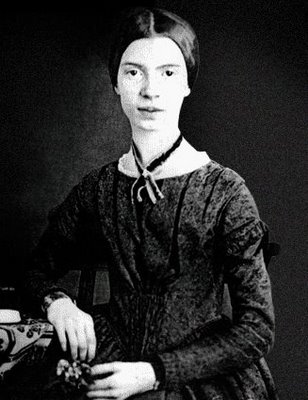 I liked how she had the good grace to keep her poems short. They are always meticulously crafted but have a defiantly crooked rhyming method that often seems ideal for her abrupt and morbid subject matter. She strikes me as being a bit of a curiosity as a person, writing thousands of agonising poems and not telling anyone. I seem to remember hearing that she was very keen on botany, but I don’t suppose that’s unusual for the well-to-do ladies of US provincial life in the nineteenth century – sitting in a stifling room lamenting unrequited love and contemplating death. I’d love to see how Edward Gorey would illustrate her poems.
I liked how she had the good grace to keep her poems short. They are always meticulously crafted but have a defiantly crooked rhyming method that often seems ideal for her abrupt and morbid subject matter. She strikes me as being a bit of a curiosity as a person, writing thousands of agonising poems and not telling anyone. I seem to remember hearing that she was very keen on botany, but I don’t suppose that’s unusual for the well-to-do ladies of US provincial life in the nineteenth century – sitting in a stifling room lamenting unrequited love and contemplating death. I’d love to see how Edward Gorey would illustrate her poems.
‘Hope is a thing with feathers’ comes up time and again as the most popular of her poems. I think that this is a fairly twee effort and certainly not one of her most interesting. I prefer ‘I measure every grief I meet’, or ‘Death sets a thing significant’.
Anyway, it’s not difficult to find all her stuff online if you care to look.
I didn’t call this post ‘Poetry’ because there’s not just Emily Dickinson; there’s always “The force that through the green fuse drives the flowers, drives my green age. ” or ‘Autmn’ or, would ‘The Divine Comedy’ count? I’m a Scotsman and therefore duty bound to cherish the works of Burns in my breast. OK, maybe something else on poetry to come…
Hogarth
 That’s Paul Hogarth, the twentieth century watercolourist and illustrator, not William Hogarth, the eighteenth century painter and engraver.
That’s Paul Hogarth, the twentieth century watercolourist and illustrator, not William Hogarth, the eighteenth century painter and engraver.
I’ve mentioned before that I was drawn to the works of Graham Greene by a series of his books with Hogarth illustrations on the cover. A few years after enjoying those books and covers I came across a great coffee table book of Hogarth’s paintings he’d done on some journey round Europe and the Mediterranean. I love how he captures vivid colours and light. Not usually what you’d expect from paintings done in watercolour. And I liked the people he dropped into his places.
Anyway, my wife got me the painting above for my birthday and it now has pride of place in our hall. Despite my rubbish photograph, you can see that water has crept onto the paper from the bottom and carried some of the paint as it seeped upwards. I’m not sure if that made it affordable, or if my wife went hugely extravagant for that particular birthday.
The painting arrived with a note from the dealer saying that the picture had been used as the frontispiece for a French edition of Conan Doyle’s Sherlock Holmes short stories titled ‘La Main Brune’ – ‘The Brown Hand’. So, naturally, I tracked this on Ebay and was absolutely delighted to eventually buy the book from a dealer in Montparnasse for a very reasonable price.
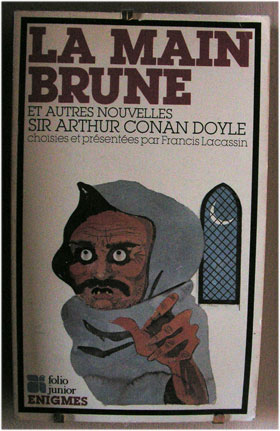 When the book arrived from France I was thrilled to see that the reproduction of the painting was made after the water damage had taken place. Odd though that the publishers removed Hogarth’s signature from the painting.
When the book arrived from France I was thrilled to see that the reproduction of the painting was made after the water damage had taken place. Odd though that the publishers removed Hogarth’s signature from the painting.
